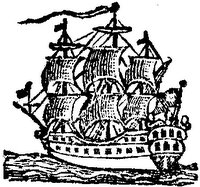Dr. Samuel Gelston on Trial
Since March I’ve been meaning to finish the story of Dr. Samuel Gelston, the Nantucket physician whom the Patriots jailed in January 1776, and then had to recapture the next month when he escaped.
In the summer of 1776, Gelston was still in custody, guarded by Berachiah Basset on Naushon Island, the biggest of the Elizabeth Islands off Cape Cod. Perhaps the authorities had sent him to such a remote place to prevent a second escape. At the time, Patriot leader and future governor James Bowdoin was Naushon’s absentee owner. (The thumbnail image here shows Naushon in winter; for a print of this or other aerial views, visit Joseph R. Melanson’s Skypic.com.)
On 5 July 1776, the Massachusetts House resolved:
That the said Berachiah Basset, Esq., be, and he hereby is, directed to send the said Dr. Samuel Gelston, under a proper Guard, to the five Justices in the County of Suffolk, appointed a Court to inquire into the conduct of persons suspected to be enemies to the liberties of this Colony...In a petition published in the New England Historical and Genealogical Register in 1874, Gelston basically threw himself on the mercy of this special court:
your petitioner by the special Order of the Honorable Court has been brought before your Honors, to answer to several Complaints brought against him, one of which was that of supplying Capt. [James] Ayscough [of the Royal Navy] with provisions, the particulars of which has been given in with Truth and Candour, & he apprehends has been Laid before your Honors.The justices were apparently in a forgiving mood, perhaps because the war looked quite different in July 1776 from how it had five months earlier. Massachusetts was no longer the center of the fighting, and the British navy no longer so close. (People had no idea that the British military had returned to Staten Island early that month, and that the worst of the war lay ahead.)
The other is for several speaches made in conversations & Threatening to spread the small Pox all of which he absolutely Denys, & presumes no positive evidence can be produced to support such a charge neither has he at any time held any Correspondence with, nor supply’d the army or navy of Britain except in the present Instance nor has he been regardless of his duty to his Creator, his Country & posterity—
Your petitioner would further beg Leave to set forth to your Honors That he has a Wife & Family consisting of Eight children, who must be Greatly distressed by his absence & confinement as well as his property Distroyed.
Therefore most Humbly Request your Honors to consider his situation with kindness and attention & if possible to suffer him to Return to his family.—He is willing with Humble Contrition to Confess his Faults & in future to behave himself with calmness and moderation in every action that may tend to promote the Good of his Country & its cause which shall be advised on every Occasion.
Once more your petitioner would beg leave to add That he is Heartily sorry that he has been so unwise as to attempt to make his Escape before he was Acquitted by your Honors, one thing was, he did not consider himself under parole & was foolishly Lead by the advice of Others.
Dr. Gelston seemed contrite about the actions he admitted to: helping Capt. Ayscough and trying to escape. Apparently no one came to testify about what he denied doing, such as spreading smallpox. (Even before the war, he’d had to deal with public fears about how he treated that disease.) So the justices sent Gelston back to Nantucket.
In 1779, as I wrote back here, Gelston was again caught up in a dispute over local Loyalists aiding a British warship that visited Nantucket—except this time he was a witness against other men. So he seems to have discarded his Loyalist sentiments and accepted the independence of Massachusetts. Dr. Gelston died in July 1782, aged fifty-seven.

